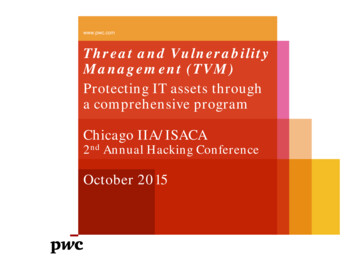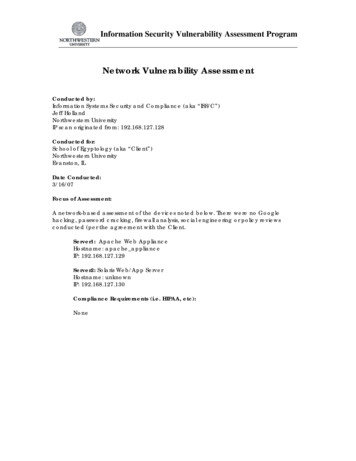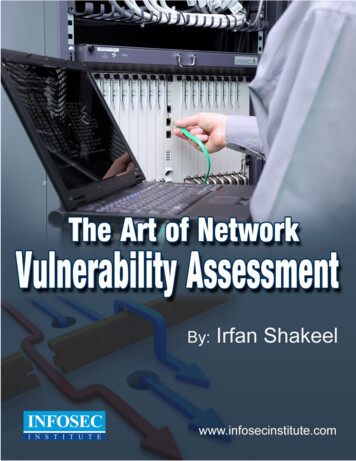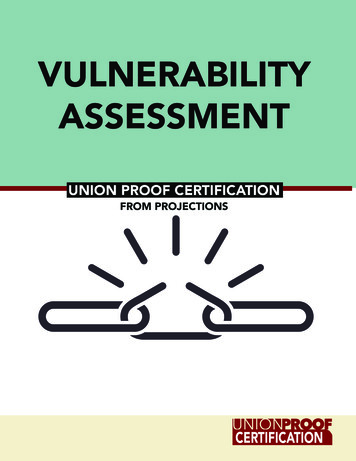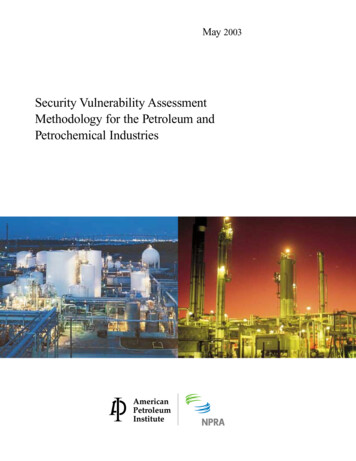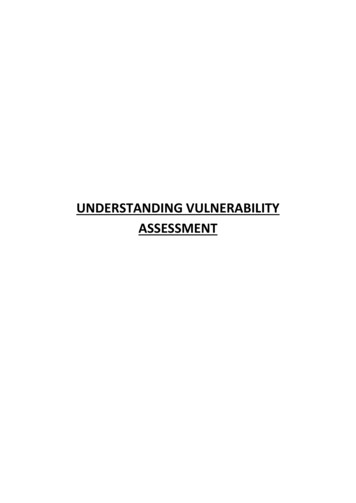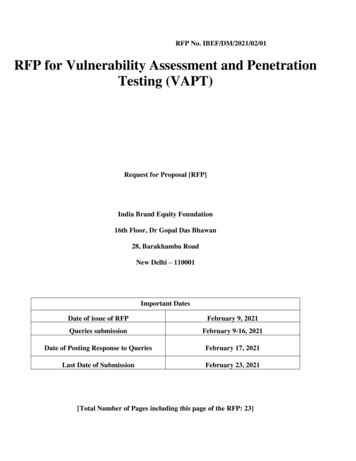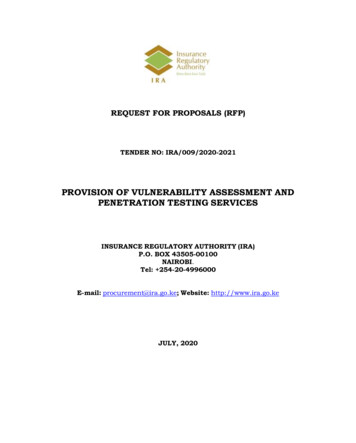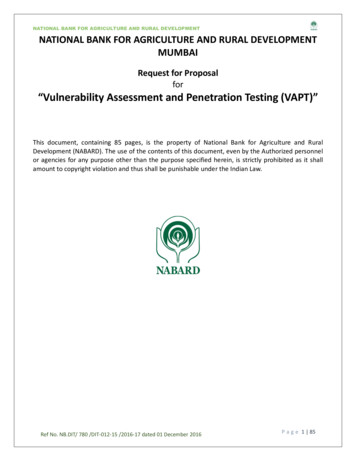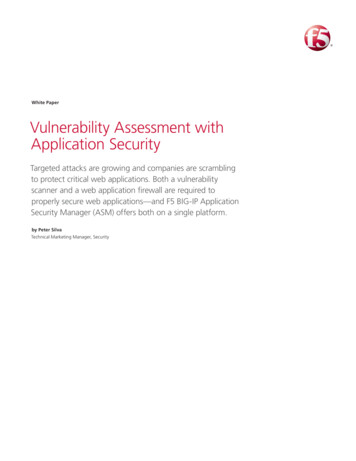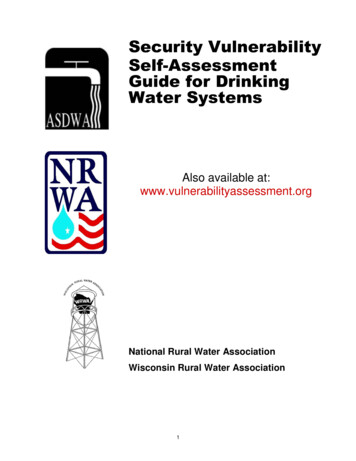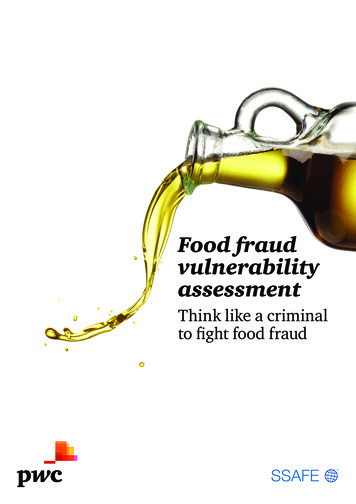
Transcription
Food fraudvulnerabilityassessmentThink like a criminalto fight food fraud
The war on food fraudFree online tool helpsfood companies protectconsumers by fightingfraud.Food fraud is a growing concern.Recent food fraud scandals haveincreased the need to protectconsumers by strengthening the foodindustry’s ability to detect and combatfraud within organisations and acrosssupply chains.The risks have never been higher. Whilefood fraud is not new, the criminalmotivation to adulterate or counterfeitfood for financial gain is growing anda new solution is needed to fight back.Current food safety managementsystems are not designed for frauddetection or mitigation, but new foodsafety guidelines require it.That is why SSAFE has collaboratedwith PwC to create a food fraudvulnerability assessment that you canuse free-of-charge to help identify yourvulnerabilities to food fraud threats.This is an industry-led solution thatsupports the Consumer Goods Forum’sGlobal Food Safety Initiative (GFSI)guidelines. SSAFE developed theassessment with PwC, WageningenUniversity, VU University Amsterdamand in consultation with food industryleaders around the world to help putyou in a stronger position to fight fraud.Want to assess yourvulnerability to food fraud?Go to www.ssafe-food.org now todownload the assessment in Excel oronline at www.pwc.com/foodfraud.The assessment will be available onthe Apple App Store or Google Playfrom January 2016.Begin your confidential, anonymousand free assessment of your foodfraud vulnerabilities today.“As a non-profit organisation SSAFEbelieves that protecting consumersis vital. And by developing this freetool we hope to reduce criminalactivity that adulterates food foreconomic gain.”Quincy Lissaur, SSAFE2
What you don’tknow can hurt youCompanies are losing money andcustomers are losing faith. Foodfraud is estimated to cost the globalfood industry US 30 to 40 billionevery year1.But beyond the economic cost, foodfraud can lead to serious publichealth risks and damage brands.Food scandals, such as horse meatbeing passed off as minced beef inEurope and melamine being addedto dairy products in China, haveincreased the urgency for the foodindustry to take action.Globalisation and increasinglycomplex supply chains are creatinghuge opportunities and rewardsfor fraudsters. The collisionof megatrends – particularlyclimate change, resource scarcity,urbanisation and demographicchange – are increasingvulnerabilities and making it easierfor criminals to profit from fraud.Today, even the most basic foods caninvolve huge numbers of suppliersaround the world.1 John Spink, Michigan State University, 2014.Small wonder, then, that foodfraud is increasing.In response GFSI is adding twonew requirements to its guidancedocument to support companiesin reducing the risks from foodfraud to their own organisation andconsumers. By requiring companiesto assess their vulnerability to foodfraud and develop control plans toreduce their vulnerabilities, fraudmitigation will become an integralpart of food safety managementsystems and a company’s enterpriserisk management framework.Our food fraud vulnerabilityassessment is purpose built tohelp companies identify areasof vulnerability and meet therequirements of all GFSI recognisedcertification schemes as well asseveral regulatory authoritiesaround the world.It’s a great place to start inidentifying your vulnerabilities andplanning your mitigation efforts.Food fraud is estimatedto cost the global foodindustry US 30 to 40billion every year.John Spink, Michigan State UniversityFood fraud vulnerability assessment3
Think like a criminalto fight food fraudEnsuring food is safely produced,transported and consumed isa shared responsibility – ourassessment tool is just one part ofthat solution, by helping you getinto the minds of fraudsters.It’s a science-based tool, based onthe study of criminal behaviour andcriminal decision making. Structuredinto two parts, the first part gets to theelements affecting criminal behaviour,while the second part relates to yourcompany and its external relationshipsand environment (such as suppliers).Food fraud vulnerability assessment conceptOpportunityrelated fraudrisk factorsMotivationsrelated fraudrisk y‘Opportunities’ and ‘motivations’ are determined by the company’s internal andexternal environment and are defined as the potential fraud risk factors. The potentialrisk resulting from these two elements can be mitigated by the third element; the‘fraud control measures’ which companies implement to detect or prevent fraud.The assessment is easy to use andcan be applied anywhere in the foodsupply chain, from animal feed andprimary production to manufacturingand catering. It applies fraud theoryto support the identification ofvulnerabilities in the food supply chain.There are three main elements –opportunities, motivations and absenceof fraud control measures – thatcriminologists believe determine acompany’s vulnerability to food fraud,which make up the focus of our foodfraud vulnerability assessment.4The assessment is easy to use andcan be applied anywhere in thefood supply chain, from animalfeed and primary production tomanufacturing and catering.
Ready to get started? A fewthings you should knowThe tool is free-to-use for any company. Go online, download the app or use the spreadsheet to complete our 50assessment questions (app available from January 2016).You can use the tool to assess your vulnerability to fraud at an ingredient, product, brand, facility, country orcompany-wide level. If you want help deciding on where to apply the tool in your organisation, complete thedecision tree.The online tool is easy to use and you have the option to delegate responsibility for completing specific questionsto different colleagues and departments to ensure its smooth completion by the right people, no matter how big orsmall your organisation.Once completed, and depending on how you decided to apply the tool, the assessment will give you a profile ofyour company’s potential food fraud vulnerability, which can form the basis for the development of interventions tomitigate identified vulnerabilities, as well as assessing potential risk to the enterprise.The assessment doesn’t give specific recommendations for mitigation techniques, but it does provide links touseful guidance on how and where to find solutions. It is not designed to detect fraud or predict future foodfraud incidents. Yet by addressing identified vulnerabilities, fraudulent activities may be identified and give youthe opportunity to stop criminal activity. You can use this tool as part of your food safety management system –remember fraud vulnerabilities change over time, so use it regularly.At the end of the assessment you’ll get a report that can be added to your food safety documentation, which includesspider web graphics that illustrate and identify potentially high-risk areas of vulnerability. The outputs will enableyou to prepare mitigation strategies and techniques, including the introduction of additional controls for reducingyour food fraud risks.Responses to the assessment remain confidential to the company carrying out the assessment. It is important to notethat respondents and their organisations are not identifiable from the online information recorded. All identifiabledata is deleted at the end of your assessment, and all remaining data is aggregated to support general benchmarkingand research to continue to improve the tool and provide additional feedback to the industry.You can use the tool to assessyour vulnerability to fraudat an ingredient, product,brand, facility, country orcompany-wide level.Food fraud vulnerability assessment5
And a few things youmay want to knowMoney, money, money motivates food fraudstersFood may be about taste andnutrition for most of us, but forfraudsters it’s always about usingfood as a pawn to make easymoney to maximise gains andminimise losses.In the graphic below are the many waysfraud is committed. So follow the moneyand you may catch a thief adulteratingor counterfeiting your xing a liquid ingredientof high value with a liquidof lower value.Replacing an ingredient,or part of the product,of high value with anotheringredient, or part of theproduct, of lower value.Hiding the low qualityof food ingredientsor product.Placing false claimson packaging foreconomic gain.UnapprovedenhancementAdding unknown andundeclared materialsto food products to enhancethe quality attributes.6We hope our tool helps inform you ofvulnerabilities in your organisation soyou can ensure criminals are less willingand less able to profit from food fraud atyour expense.CounterfeitingCopying the brandname, packaging concept,recipe, processing methodetc. of food productsfor economic gain.Grey market production/theft/diversionSales of excessunreported product.Note that ‘grey market production/theft/diversion’is out of the scope for this assessment tool (butmay be picked up anyway).
Building resilienceFighting food fraud from farm to forkThe global food industry is calling time on food fraud, with the GFSI adding the following tworequirements to its guidance document to help food companies reduce their risks from fraud.1. Food fraud vulnerabilityassessmentFood organisations should assessand document their vulnerability tofood fraud to identify potential risksand prioritise food fraud mitigationmeasures.2. Food fraud mitigation planFood organisations should have adocumented plan that specifies howit is reducing public health risks fromidentified food fraud vulnerabilities. Thisplan will cover the relevant GFSI scopeand be supported by the organisation’sfood safety management system.With the use of our freely-availableonline tool it will put you in a strongerposition to identify vulnerabilities,reduce risks and give consumers greaterconfidence in the safety of your food.We recommend you use this assessmenttool at part of your overall food safetymanagement system.Food safety management systemFood safetyFood defenceFood fraudMitigation ofunintentional/accidentaladulterationMitigation ofintentionaladulterationMitigation ofintentionaladulterationScience basedIdealogically basedEconomically basedFood fraud vulnerability assessment7
What’s your vulnerabilityto food fraud?www.pwc.com/foodfraud www.ssafe-food.orgWant to speak to us?Get in touch Quincy Lissaur, SSAFE’s Executive Director:qlissaur@ssafe-food.org Craig Armitage, PwC’s Global Leader, Food Supply and Integrity Services:craig.armitage@nz.pwc.com Or speak with your local SSAFE or PwC contact for supportOr speak with your local SSAFE or PwC contact for support Hans Schoolderman, PwC Partner Sustainability & Responsible Governance:(0)88 792 7658,Partnerhans.schoolderman@nl.pwc.com Tel:PwC’sEuropeanLeader, FoodSupply and IntegrityServices: Hans 31Schoolderman,PwCSustainability& ResponsibleGovernance:Tel: 31(0)88 Senior792 76Manager:58, hans.schoolderman@nl.pwc.com OnnoNillesen,Tel: 31(0)887926414, onno.nillesen@nl.pwc.com Onno Nillesen, Senior Manager: Tel: 31 (0)88 792 64 14, onno.nillesen@nl.pwc.comSSAFE is a non-profit membership driven organisation that aims to foster the continuous improvement and global acceptance of internationally recognised food protection systems and standards through public-private partnerships. What makes SSAFE unique is its focus on driving collaborationbetween the public and private sector to enhance the integrity of the food supply chain.At PwC, our purpose is to build trust in society and solve important problems. We’re a network of firms in 157 countries with more than 208,000people who are committed to delivering quality in assurance, advisory and tax services. Find out more and tell us what matters to you by visiting usat www.pwc.com.PwC provides Food Supply and Integrity Services. PwC does not assure the safety of any particular food or the outcome of any food service orprocess. These materials and any views expressed therein are provided for general information purposes only. They do not constitute a recommendation or advice and are not sufficient basis for any decision to be made in relation to food supply and integrity issues. 2015 PwC. All rights reserved. PwC refers to the PwC network and/or one or more of its member firms, each of which is a separate legal entity.Please see www.pwc.com/structure for further details.
fraud vulnerability assessment. Food fraud vulnerability assessment concept ‘Opportunities’ and ‘motivations’ are determined by the company’s internal and external environment and are defined as the potential fraud risk factors. The potential risk resulting from thes
